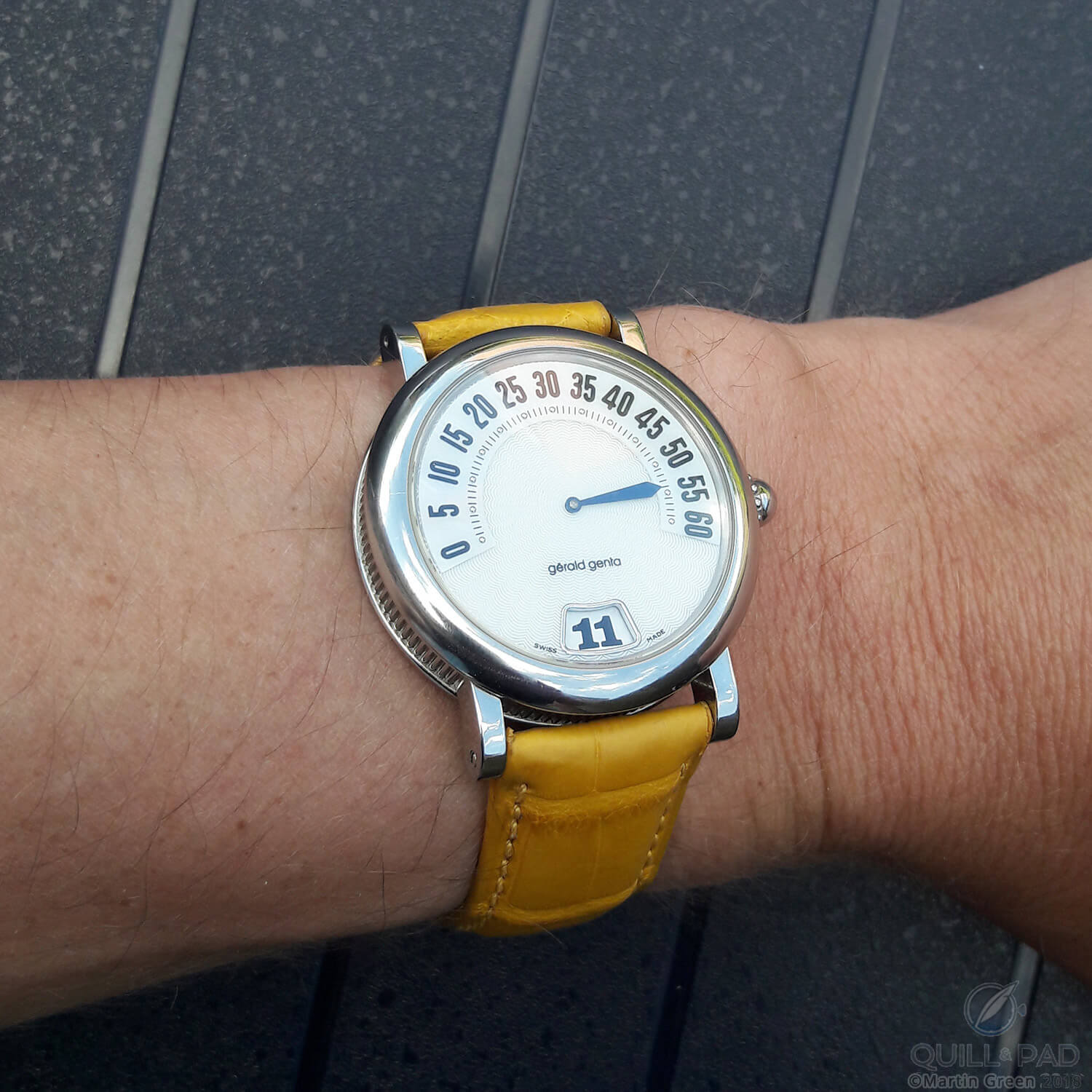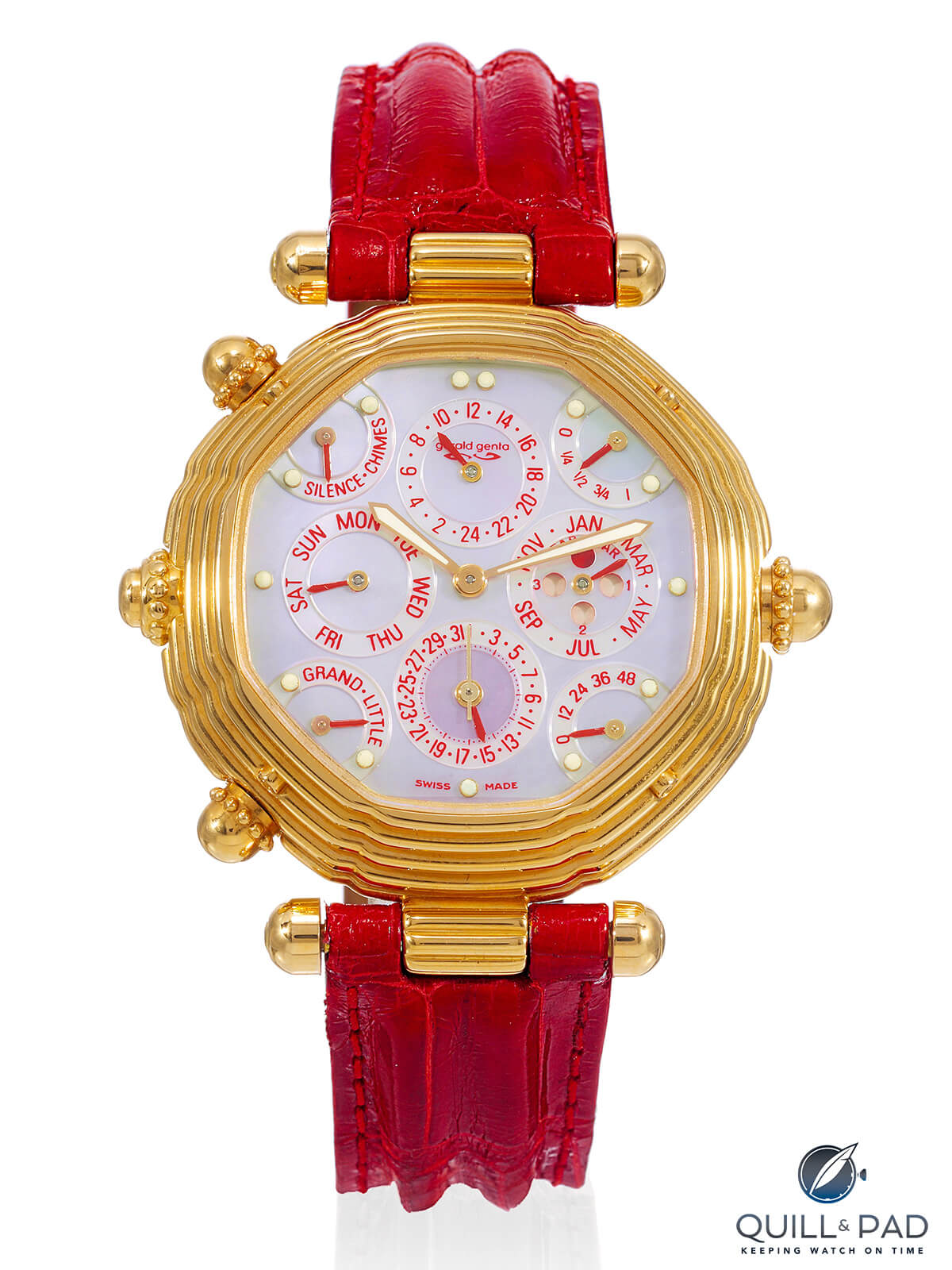Gérald Genta: Legendary Watch Designer With A Renegade Spirit
by Martin Green
Gérald Genta’s (1931-2011) claim to eternal horological fame is closely connected to the rise of high-end stainless steel watches. With both the Audemars Piguet Royal Oak (1972) and the Patek Philippe Nautilus (1976) stemming from this designer’s hand, in the 1970s Genta played a critical role in making stainless steel the new gold.

Original Audemars Piguet Royal Oak from 1972

Gérald Genta (photo courtesy Gérald Genta Heritage Association)
Genta was very active during his lifetime, and alongside designing these two icons, he also sketched the contours of many other watches. While many remain a mystery to today, hidden behind the confidentiality clauses that are so common in this field, some of Genta’s other designs are known.

Patek Philippe Reference 3700 Nautilus from 1976 (photo courtesy Kristian Haagen)
Genta also designed the Universal Genève Polerouter (1954), the Patek Philippe Golden Ellipse (1958), the IWC Ingenieur (1976), the Cartier Pasha, and several models by Omega (the Constellation of 1960, for example).
While that list alone is enough to make Gerald Genta a legend, there is another aspect not as widely recognized, yet still very interesting.
Gérald Genta: the first modern innovator
Genta has a strong claim as the first “independent.” Already in 1969 he founded a company under his own name. This is quite significant, as that date is not only three years before he designed the Royal Oak, but it was also a time during which the quartz crisis was just beginning to wreak its havoc.
Genta created a design company and his own brand: the former to generate income, the latter so he could let his imagination run wild. For Genta such a place might have been a necessity; it gave him space to give his inventiveness free rein and test out entirely new concepts.

Gérald Genta Retro Classic on the wrist
Among Genta’s most successful creations was the Retro, which combined a jump hour with a retrograde minute hand. At the time of its introduction, this was an unusual combination of complications: both are quite volatile as the movement needs to build up power over the course of an hour to instantly and simultaneously reset the minute hand and jump the hour forward.
The animated hands provide the watch with a visual spectacle, which made it popular among watch connoisseurs. Genta loved to experiment with this design, working with mother-of-pearl, guilloche, and multilevel dials.

Gérald Genta Retro Fantasy Donald Duck (photo courtesy Antiquorum)
Genta also made a deal with Disney that allowed him to use well-known characters such as Mickey Mouse and Donald Duck on his dials. By taking advantage of the retrograde minute hand, he was able to have these well-known figures swing a bat or hit a golf ball, making his designs even more expressive.
Gérald Genta: pushing the envelope
In 1988, Genta surprised the watch world with the Gefica, a watch made with a safari theme in mind. Through it, Genta can be credited for being among the first to use a bronze case in mainstream watchmaking. He daringly combined it with a strap made of elephant leather.

Gérald Genta Gefica Safari Chronograph, approx. 1988 (photo courtesy Antiquorum)
The Gefica Safari Chronograph made a bold statement that looked amazing then, but in today’s world would probably result in outraged comments. A few decades ago this was less of an issue, and Genta introduced the Gefica in several different variations (Bulgari also re-introduced it under the Genta name in 2007 after taking over the company).

Gérald Genta Gefica Safari
Perhaps it is because he was first and foremost a designer, but Genta was able to switch very fluidly between quartz and mechanical movements. He most likely selected the movement to best suit the design that he had in mind.
It is interesting to note that when Genta used quartz he often opted for a movement with an additional complication such as a second time zone or even a complete or perpetual calendar.
Yet also when it came to mechanical movements, he loved to push the envelope. This became especially clear in 1994 when he celebrated the twenty-fifth anniversary of his company with an incredible watch.
This was the famed Gérald Genta Grande Sonnerie. I never understood the name as this is only one of the many complications featured in that watch that also features a tourbillon, second time zone, perpetual calendar, and Westminster chime.

One of the many variations on the Gérald Genta Grande Sonnerie (photo courtesy Antiquorum)
Genta’s Grande Sonnerie was fitted with two spring barrels, one for the movement and one for the sonnerie; both also had power reserve indicators on the dial, which gave the watch somewhat of a crowded look.
With a height of just 8.9 mm, the complex movement was still surprisingly slender, given that it not only housed all these complications but also featured automatic winding. Genta created an exceptional case that can best be described as a pyramid of rounded octagonal bezels, making the watch even more expressive and distinctive.
Gérald Genta: saying goodbye, but not quite
Genta sold his brand in 1998 to the Singapore-based watch store chain The Hour Glass. Financial difficulties forced the company, unfortunately, to sell the brand only two short years later.

A historical automatic Bvlgari Bvlgari perpetual calendar: Genta’s influence is clearly visible in the retrograde display at 6 o’clock (photo courtesy Bulgari)
Then the brand ended up in the hands of one of Genta’s former clients, Bulgari. For this Italian-Swiss brand he had designed the Bvlgari Bvlgari in 1977, a subtle design that boldly displayed the brand’s name not once, but twice engraved on the bezel.
Initially, Gérald Genta remained a standalone brand under the auspices of Bulgari. But as time passed, economic circumstances saw Bulgari integrate Genta’s designs within its own lineup.
While watch connoisseurs mourned this decision at first, it also gave rise to a new icon: the Bulgari Octo, which can now be seen as one of the brand’s main pillars and a model that, especially with its record-breaking Octo Finissimos, has made quite an impact.

Bulgari Octo Finissimo Automatic on the wrist
Selling his firm did not mark a natural moment for Genta to rest on his laurels; he simply went on to found yet another brand. As he had sold the rights to his name, he had to use his middle name for this one, so Gerald Charles was born.

Gerald Charles Anniversary Watch
These designs were just as expressive as previous one, and for some of his creations he worked together with independent watchmakers like Antoine Preziuso, who created a tourbillon movement for him.
Genta passed away on August 17, 2011. However, his legacy continues . . . in the Royal Oak, Nautilus, and Octo collections for example. And in 2018 Bulgari relaunched the Gérald Genta Collection.

Bulgari’s commemorative Gérald Genta Retro of 2019
For this, the Italian brand used the Retro as the celebratory model with a date function in a platinum case. This watch contains all the hallmarks that made it such a delicacy within the world of watches in the first place with its clean yet expressive design. It is slightly different from the original, yet one that could undeniably be from Genta’s own hand.
Quick Facts Gérald Genta Retro Classic
Case: 38 x 10 mm, three-piece in stainless steel
Movement: automatic Gérald Genta Caliber 4503 (base ETA 2892-A2 with module for retrograde minutes and jump hour)
Functions: jump hour, retrograde minutes
Years of manufacture: 1997 to approx. 2004
Price: only available on secondary market, estimate $3,500
Quick Facts Gérald Genta Gefica Safari 2007
Case: 46.5 x 19.3 mm, bronze, water-resistant to 100 meters
Dial: brass with bronze and silver or bronze and black galvanic coloring
Movement: automatic Caliber GG 1004 (based on Girard-Perregaux Caliber 3100 with bi-retrograde module)
Functions: jump hours, retrograde minutes; retrograde date
Price: $14,200 at retail in 2007
You may also enjoy:
Gérald Genta Retro Classic: The Definitive Genta Masterpiece?
Would You Buy A Watch From A Defunct Brand If The Price Was Right? Here’s What You Should Consider
Leave a Reply
Want to join the discussion?Feel free to contribute!



It is weird how I have a love/hate relationship with Genta. I love the Polerouter (obviously), love the Royal Oak, find the Nautilus and the Constellation fine but largely overrated, and pretty much hate everything else he designed.
I guess even the most die hard fans will agree, though, that the Grande Sonnerie isn’t ready to come back into fashion in the next few years…
Lol, that Grande Sonnerie was even too much for me at times! But in general, I loved his independent designs so much more than the corporate ones. And that’s usually why I love the independents so much: the funky, playful nature of their creations. I really think Genta is a case by case for most people.
I bet it’s a pain to manufacture the sapphire glass on that Gerald Charles Anniversary watch.
It is an unfortunate aspect of the way the industry operates that Gerald Genta was unable to use his famous name on a watch. His launch of Gerald Charles in 1998 was not a success. Martin Braun was later to face the same problem.
Gerald Genta did design many iconic watches but you should check if he designed the PP Golden Ellipse. I do not believe he did
On Mr. Genta’s own site, it states that he did: https://geraldcharles.com/maison/#timeline/1958
Current Octos are great but early pre-Bulgari Octos were gorgeous. Also, no mention of the IWC Ingenieur?